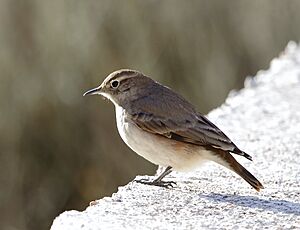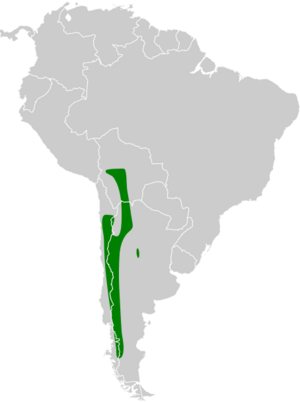Rufous-banded miner facts for kids
Quick facts for kids Rufous-banded miner |
|
|---|---|
 |
|
| In the Andes of Mendoza, Argentina | |
| Conservation status | |
| Scientific classification | |
| Genus: |
Geositta
|
| Species: |
rufipennis
|
 |
|
The rufous-banded miner (Geositta rufipennis) is a special kind of bird. It belongs to a group of birds called ovenbirds. You can find this bird in South America, specifically in Argentina, Bolivia, and Chile.
Contents
About the Rufous-Banded Miner
The rufous-banded miner is a medium-sized bird. It usually measures about 14 to 17 centimeters (5.5 to 6.7 inches) long. It weighs between 25 and 54 grams (0.9 to 1.9 ounces). Both male and female birds look very similar.
What Does This Bird Look Like?
The main type of rufous-banded miner has a brownish-gray face. It has a light stripe above its eye and a dark line behind it. Its back, from its head to its tail, is a dull sandy olive color.
Its tail feathers are interesting! The middle ones have dull reddish-brown bases and grayish-brown middles. They also have a wide black band near the end and dull reddish-brown tips. The other tail feathers have more red at their bases and smaller black bands.
The bird's wings are dull gray-brown with lighter edges. The flight feathers have reddish-brown bases, which create a wide band on the wing. Its throat is whitish, and its chest is a pale brownish-yellow. Its belly and sides are even lighter, with a hint of cinnamon.
The rufous-banded miner has brown eyes. Its beak is straight and medium-sized, blackish-gray with a light horn color at the base. Its legs and feet are blue-gray.
Different Types of Rufous-Banded Miners
There are several different types, or subspecies, of the rufous-banded miner. These types can be different sizes and have slightly different colors.
- One type, G. r. ottowi, is larger and grayer than the main type. It has narrower wing bars and lighter undersides to its wings.
- Another type, G. r. hoyi, has mostly gray upper parts. Its underparts are mostly pinkish-gray.
- G. r. giaii is similar to hoyi but is a bit darker gray on top. It has narrower wing bands and a much longer beak.
- G. r. fasciata has grayer upper parts and is darker overall.
- G. r. harrisoni is the smallest type. It has a whiter belly and very little or no reddish color on its sides and under its tail.
Where Do Rufous-Banded Miners Live?
The rufous-banded miner lives in different parts of South America.
- G. r. fasciata lives in western Bolivia and the Pacific coast of Chile.
- G. r. harrisoni is found in southwestern Chile.
- G. r. rufipennis lives in northwestern Argentina.
- G. r. giaii is found in southwestern Argentina and possibly southern Chile.
- G. r. ottowi lives in central Argentina.
- G. r. hoyi is found in western Argentina and southern Chile.
These birds like to live in open areas. You can find them in grassy plains, dry mountain areas with scattered bushes, and rocky slopes. They also live in flat areas with some plants and dry riverbeds. In the Andes mountains, they live at very high elevations, from about 3,100 to 4,400 meters (10,000 to 14,400 feet) above sea level. In other areas, they can be found as low as 2,200 meters (7,200 feet) and even near sea level in parts of Chile.
Life and Habits of the Rufous-Banded Miner
Movement and Migration
Most rufous-banded miners stay in the same place all year. However, some populations in Argentina and Chile move to lower elevations after the breeding season. The birds living furthest south might move north after breeding. Sometimes, large groups of these birds, with up to 500 individuals, can be seen migrating.
What Do They Eat?
The rufous-banded miner finds its food on the ground. It usually searches alone or in pairs. Their diet mainly consists of small insects and other arthropods. They also eat seeds and leaf buds.
Reproduction and Nesting
Rufous-banded miners breed during the summer months in the Southern Hemisphere. They are thought to have one partner for life. These birds usually dig a horizontal tunnel in an earthen bank or slope. At the end of the tunnel, they create a larger chamber for their nest. Sometimes, they might nest in a crack in a rock instead. They line their nest with soft materials like grass, hair, and feathers. A female rufous-banded miner typically lays two or three eggs.
How Do They Communicate?
The song of the rufous-banded miner is a fast series of buzzing, trilled notes, all at the same pitch. Sometimes, it includes bursts of faster notes. They sing their song from a perch on a rock or while flying in a special display flight.
Conservation Status
The International Union for Conservation of Nature (IUCN) has listed the rufous-banded miner as a species of "Least Concern." This means that while its population size is not known and is believed to be decreasing, it is not currently in immediate danger of disappearing. The bird has a large area where it lives and is considered fairly common throughout its range. It is generally safe from human activities, except for issues like overgrazing by animals in some areas.
Images for kids




